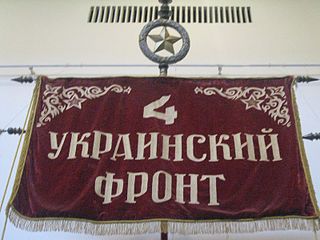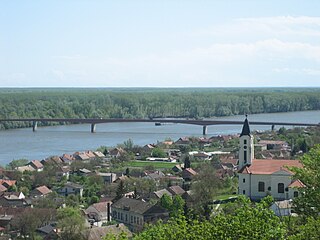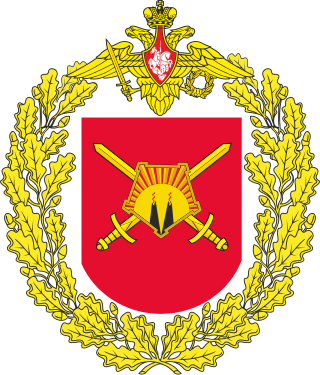
The 4th Ukrainian Front was the name of two distinct Red Army strategic army groups that fought on the Eastern Front in World War II.

Batina is a port village on the right bank of the Danube river in Baranja, Croatia. It developed into the local center of the northeastern part of Baranja, in the part of Bansko brdo hill where the slopes reach the Danube river.

The 19th Voronezh-Shumlinskaya Red Banner Order of Suvorov and Red Banner of Labor Motor Rifle Division, is a division of the Russian Ground Forces. It appears to have been formed originally in July 1922 at Tambov in the Moscow Military District as a territorial formation. In 1923 it was awarded the 'Tambov' placename and renamed the 19th Voronezh Rifle Division. The division was downsized to a brigade in 2009 and reestablished as a division in 2020.
The 63rd Army was a field army established by the Soviet Union's Red Army during World War II.

The 39th Separate Guards Red Banner Motor Rifle Brigade is a mechanized infantry brigade in the Russian Ground Forces. Originally formed as the Blagoveshchensk Fortified Region of the Soviet Union's Red Army in 1932, it became the basis for the 2nd formation of the 342nd Rifle Division and took part in the Soviet invasion of Manchuria. During the Cold War, it was reformed as the 56th Motor Rifle Division and later re-designated as the 33rd Separate Motor Rifle Division. In 2009, it was downsized and reorganized into the 39th Separate Motor Rifle Brigade as part of the 2008 Russian military reform.

The 51st Army was a field army of the Red Army that saw action against the Germans in World War II on both the southern and northern sectors of the front. The army participated in the Battle of the Kerch Peninsula between December 1941 and January 1942; it was destroyed in May 1942 with other Soviet forces when the Wehrmacht launched an operation to dislodge them from the peninsula. The army fought in the Battle of Stalingrad during the winter of 1942–43, helping to defeat German relief attempts. From late 1944 to the end of the war, the army fought in the final cutting-off of German forces in the Courland area next to the Baltic. Inactivated in 1945, the army was activated again in 1977 to secure Sakhalin and the Kuril Islands. Following the dissolution of the Soviet Union, the army continued in existence as a component of the Russian Ground Forces. The army was active during two periods from 1941 until 1997.

The Belgrade offensive or the Belgrade strategic offensive operation was a military operation during World War II in Yugoslavia in which Belgrade was liberated from the German Wehrmacht through the joint efforts of the Soviet Red Army, Yugoslav Partisans, and the Bulgarian Army. Soviet forces and local militias launched separate but loosely cooperative operations that undermined German control of Belgrade and ultimately forced a retreat. Martial planning was coordinated evenly among command leaders, and the operation was largely enabled through tactical cooperation between Josip Broz Tito and Joseph Stalin that began in September 1944. These martial provisions allowed Bulgarian forces to engage in operations throughout Yugoslav territory, which furthered tactical success while increasing diplomatic friction.
The 26th Army was a field army of the Soviet Union's Red Army, active from 1941.

The 16th Vojvodina Division was a Yugoslav Partisan division that fought against the Germans, Independent State of Croatia (NDH) and Chetniks in occupied Democratic Federal Yugoslavia during World War II.

The 36th Vojvodina Division was a Yugoslav Partisan division that fought against the Germans, Independent State of Croatia (NDH) and Chetniks in occupied Democratic Federal Yugoslavia during World War II.
The 5th Mechanised Corps was a mechanised corps of the Red Army, formed on three occasions. It was first formed in 1934 and was converted into the 15th Tank Corps in 1938. It was reformed in the Far East in 1940 and moved west before the German invasion of the Soviet Union. It fought in the First Battle of Smolensk, losing large numbers of tanks in the Lepel counterattack. The corps was encircled in the Smolensk pocket and after breaking out was disbanded in late August 1941. Its third formation, from elements of the 22nd Tank Corps, occurred in September 1942. The corps fought in: Operation Little Saturn, Operation Gallop, the Second Battle of Smolensk, the Dnieper–Carpathian Offensive, and the Second Jassy–Kishinev Offensive. In September 1944, it became the 9th Guards Mechanised Corps.

The 252nd Rifle Division was the eighth of a group of 10 regular rifle divisions formed from cadres of NKVD border and internal troops as standard Red Army rifle divisions, very shortly after the German invasion, in the Moscow Military District.

The 51st Rifle Division was an infantry division of the Soviet Army, formed twice. Its first formation was formed during the Russian Civil War and fought in the Perekop-Chongar Offensive in 1920. It also fought in the Soviet invasion of Poland, Winter War and World War II. During World War II, it fought in the Battle of Rostov, Barvinkove-Losowaja Operation and Second Battle of Kharkov before being destroyed at the Battle of Voronezh. Officially disbanded on 28 November 1942, the division was reformed on 15 April 1943 from the 15th Rifle Brigade. The 2nd formation fought in Operation Bagration and the Battle of Königsberg. It was disbanded in an executive order by Premier Joseph Stalin in 1946.
The 81st Guards Rifle Division is an infantry division of the Russian Ground Forces, previously serving in the Red Army and the Soviet Army. It was formed after the Battle of Stalingrad from the 422nd Rifle Division in recognition of that division's actions during the battle, specifically the encirclement and the siege of the German forces in the city. The 81st Guards continued a record of distinguished service through the rest of the Great Patriotic War, and continued to serve postwar, as a rifle division and later a motor rifle division, until being reorganized as the 57th Separate Guards Motorized Rifle Brigade in 2009 in the Russian Ground Forces. Most of its postwar service was in the Soviet (Russian) far east, where it was originally formed as the 422nd.

The 390th Rifle Division was an infantry division of the Soviet Union's Red Army during World War II. It was formed twice, first in August 1941, and after its destruction in 1942, re-formed in 1944.
The 396th Rifle Division was created in 1941 as an infantry division of the Red Army and was activated twice during the Great Patriotic War. The division followed a very similar combat path to that of the 398th Rifle Division in its 1st formation. It was first formed in August in the Transcaucasus Military District. In January 1942 it was moved to the Crimea where it joined first the 47th and then the 44th Armies in Crimean Front. On 8 May it came under attack by the German 11th Army as part of Operation Trappenjagd and by the end of the month it was destroyed in the Kerch peninsula, being officially disbanded on 14 June. In the buildup to the Soviet invasion of Manchuria a new 396th was formed in the Far Eastern Front in early 1945. The new division was one of only three formed in 1945 and served with the 2nd Red Banner Army, crossing the Amur River on 11 August and helping to reduce a Japanese fortified zone while also marching towards central Manchuria. Its rifle regiments were all decorated for their achievements and the division was disbanded before the end of the year.
The 61st Guards Rifle Division was formed as an elite infantry division of the Red Army in January, 1943, based on the 2nd formation of the 159th Rifle Division, and served in that role until after the end of the Great Patriotic War.
The 63rd Mountain Rifle Division was formed as a specialized infantry division of the Red Army in July 1936, based on the 2nd Georgian Mountain Division. When the German invasion of the Soviet Union began it was in the Transcaucasus Military District and was soon assigned to the 47th Army for the invasion of Iran. Following this it was moved to the western Caucasus region where it joined the 44th Army of Crimean Front for amphibious operations against the Axis forces in the Crimea. In late December 1941 it landed at Feodosia as part of 9th Rifle Corps. Along with the remainder of the Corps the 63rd Mountain hindered but failed to block the retreat of Axis forces from Kerch, where the 51st Army had also made landings. After a German counteroffensive retook Feodosia in mid-January 1942 the division fell back to the Parpach Isthmus where it took part in trench warfare near the Black Sea coast into the spring, gradually losing strength. On May 8 it was caught up in the opening stage of Operation "Bustard Hunt" (Trappenjagd) and in a few hours was overwhelmed and largely destroyed by German air and artillery bombardment in support of infantry and armor attacks. Less than a week later it was stricken from the Red Army's order of battle and was never rebuilt.
The 233rd Rifle Division was an infantry division of the Red Army, originally formed in the months just before the start of the German invasion, based on the shtat of September 13, 1939. As part of 20th Army it was moved from the Moscow Military District to the front west of Orsha by July 2. Serving under Western Front the 20th was soon pocketed in the Smolensk region and although remnants of the 233rd were able to escape the division was no longer combat-effective and was broken up for replacements in early August.
The 236th Rifle Division was formed as an infantry division of the Red Army after a motorized division of that same number was reorganized in the first weeks of the German invasion of the Soviet Union. It was based on the shtat of July 29, 1941, although it was briefly redesignated as a mountain rifle division prior to making an amphibious landing at Feodosia in late December. This overly ambitious undertaking by Crimean Front's 44th Army led to a disaster when a German counterattack retook the port, destroying much of the division's personnel and equipment. The remnants of the division were forced to evacuate the Crimea in the wake of the German counteroffensive in May.













